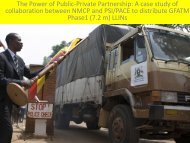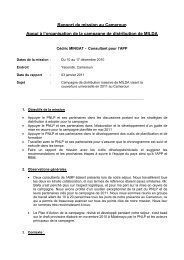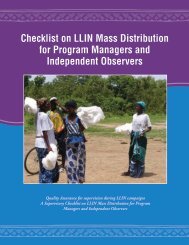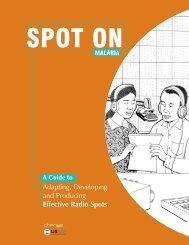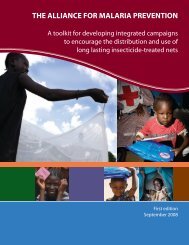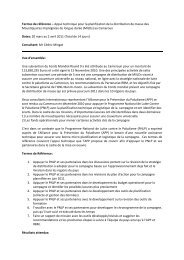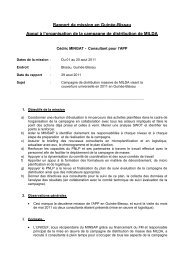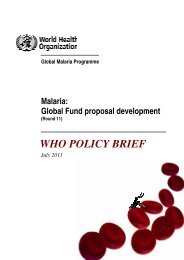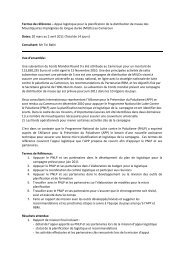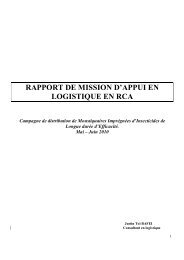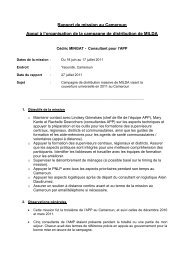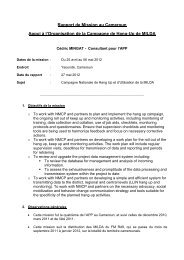Anambra State Post-Campaign Net Tracking Survey
Anambra State Post-Campaign Net Tracking Survey
Anambra State Post-Campaign Net Tracking Survey
You also want an ePaper? Increase the reach of your titles
YUMPU automatically turns print PDFs into web optimized ePapers that Google loves.
<strong>Anambra</strong> LLIN campaign evaluation<br />
The registration process was not optimal with 80.0% of households registered but the main<br />
problem in the case of <strong>Anambra</strong> was the mobility of the people, especially in the urban areas.<br />
Once a household was registered, the delivery of LLIN was highly effective and very equitable. Of<br />
those registered, 92.3% also received any LLIN; among those that actually went to the<br />
distribution point, 94.0% received any LLIN and 86.2% received at least 2 LLIN, as they were<br />
entitled to. This provides strong evidence that the organization of the LLIN distribution beyond<br />
the registration process was very successful and equitable as supported by a concentration<br />
index slightly below 0, i.e. with evidence for a pro-poor distribution.<br />
Coverage with “one net for every two people” remained moderate (42.9%) which was due to<br />
two main reasons: the sub-optimal registration levels mentioned before and the fact the<br />
distribution was limited to two nets per household which meant that any household with more<br />
than four members would not fulfil the criteria even if they received the two LLIN from the<br />
campaign. However, this target for universal coverage was not the explicit target of the<br />
campaign and is still under debate within the international community so that this can hardly be<br />
seen as decisive criteria for the assessment of campaign success.<br />
According to NMCP information 1,784,523 LLIN were allocated to <strong>Anambra</strong> <strong>State</strong> based on<br />
892,262 households and two nets per household. This figure builds on the projected 2009<br />
population of 4,461,308 [2] applying an average household size of 5.0 based on the general<br />
household definition of “people eating from the same pot”. Of the calculated number of LLIN<br />
1,613,141 were reported to have been distributed in August 2009 (90.4%). Using the survey<br />
data on average household size and mean number of LLIN received per household with the<br />
respective uncertainties in combination with the 2010 population estimate from the census the<br />
estimated number of LLIN distributed from the survey varies between 1,411,146 and 1,933,303<br />
or an “excess” of 320,162 LLIN and a “deficit” of 201,995 and (-20% to 13% of the LLIN reported<br />
as distributed). If an average household size of 5.0 persons/household is assumed then the<br />
estimated difference to the LLIN reported distributed by NMCP ranges between -37,900 to<br />
328,998 LLIN (-2% to 20%). These estimates have to be interpreted very cautiously as<br />
inaccuracies in the census estimates and growth rate projection could significantly have<br />
influenced the results. However, they suggest that the distribution figures match the survey data<br />
quite well and that no major leakage of LLIN occurred in <strong>Anambra</strong> <strong>State</strong>.<br />
Retention, hanging and use of nets<br />
Retention of campaign nets observed in <strong>Anambra</strong> <strong>State</strong> was 98.4% or a loss/attrition rate of<br />
1.6% after 4 months. This is very much in keeping with attrition rates observed in the other postcampaign<br />
surveys undertaken in Nigeria (see Table 21) and very similar to findings in Adjumani<br />
District in Northern Uganda with a loss rate of 1.7% seven months after distribution, Togo with<br />
2.8% after nine months and Niger (the country) with 2.3% also after nine months. In addition,<br />
the evidence suggests that nets were lost mainly by giving them to family and friends because<br />
they were perceived as not needed at the time. This allows the inference that selling of the<br />
received campaign LLIN into the commercial market did certainly not occur at household level<br />
and if any leakage occurred (see previous paragraph), this was at higher levels of the distribution<br />
chain.<br />
Hanging of at least one of the LLIN from the campaign within one month was reported by 77.0%<br />
of households that received any campaign nets and at the time of the survey, 61.1% of the<br />
46


